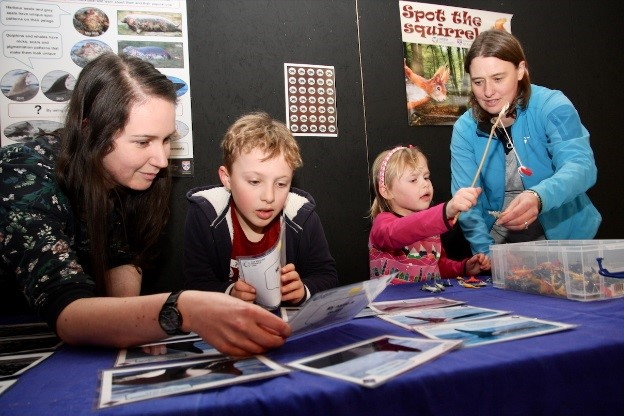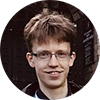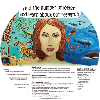Outreach and public engagement
The School of Mathematics and Statistics strongly believes in engaging with the next generation of mathematicians and statisticians through a range of outreach and public engagement activities.

The School welcomes approaches from external organisations, groups and individuals to interact and participate in the world of mathematics and statistics. Here you can see some of the events the School organises and takes part in.
Contact
Dr Tom Elsden, Outreach Officer
Email: te55@st-andrews.ac.uk
Recent events
-
Saturday 11 July 2020 to Saturday 1 August 2020
-
Sunday 28 June to Friday 3 July 2020
-
Prize giving June 2020 in St Andrews (Cancelled due to Coronavirus)
-
Wednesday 12 February 2020
-
30 September to 6 October 2019
Below are some examples of staff who are very enthusiastic about outreach activities and would be delighted to visit local schools or attend other events in order to give maths lectures at a variety of levels.
Feel free to contact individuals directly if you know what you are looking for (follow link to personal webpage to find contact information). If you want to speak to somebody more generally, then please contact Jonathan Fraser or Hannah Worthington who are the current Outreach team.
Jonathan Fraser, Professor
Jonathan is a pure mathematician working mostly with 'fractals'. Roughly speaking, a fractal is an object which exhibits interesting behaviour on a large range of scales, such as stock market fluctuations, or the surface of a lung. Fractals appear in many contexts across science and Jonathan's research focuses on the abstract mathematics which underpins fractal behaviour. He is very enthusiastic about outreach and would be delighted to discuss potential opportunities for outreach lectures, which could be on a variety of topics including fractals (of course), number theory, or various aspects of geometry, for example 'hyperbolic'.

Email: jmf32@st-andrews.ac.uk
Hannah Worthington, Lecturer
Hannah is a statistician who primarily investigates animal populations. Hannah’s research looks to answer questions about animal behaviour such as breeding ages and movement between sites, survival probabilities and factors influencing survival and trying to estimate population sizes of sometimes difficult to catch species. Hannah is happy to speak to students of any age about her research, or statistics in general, through talks or interactive activities.

Email: hw233@st-andrews.ac.uk
Amlan Banaji, PhD Student
Amlan is a PhD student whose research is on fractal geometry. He is interested in abstract mathematical properties of “fractals,” which often have an intricate and beautiful structure and can mirror natural objects like ferns. In particular, Amlan studies the different ways that one can describe the “dimension” of a fractal; these “dimensions” will not usually be whole numbers. He would be very happy to talk about his research or what it is like to be a PhD student.
.png)
Email: afb8@st-andrews.ac.uk
Cosima Breu, Research Fellow
Cosima is an astrophysicist who is mainly interested in the Sun, the star our daily life revolves around. She studies the processes supplying mass and energy to the several million Kelvin hot solar atmosphere using simulations run on supercomputers. Recently, she has also become interested in the atmospheres of other stars.
Cosima is happy to talk about astrophysics, computational fluid dynamics and high performance computing.
Email: cab42@st-andrews.ac.uk
Tom Elsden, Lecturer
Tom is an applied mathematician, who studies the interaction between the Sun and the Earth in space. He has a particular focus on `Space Weather’, which considers the effect of this interaction on humanity by predicting the `real-time' conditions in space, very much as we do with the standard weather forecast. He uses computers to solve complex systems of equations which describe how the `plasma’ (a fluid of charged particles) near Earth reacts to large scale expulsions of material from the Sun. Tom has delivered several talks to high school pupils on the topic of how applied mathematics can be used to study our local space environment. He would be very happy to discuss any opportunities for outreach lectures on this topic, as well as concepts in applied mathematics more generally.

Email: te55@st-andrews.ac.uk
Yoav Len, Lecturer
Yoav is a mathematician working in geometry. He is mostly interested in shapes obtained from solutions to polynomial equations, and in particular, the combinatorial aspects of such shapes. Polynomial equations play a central role in many areas of science such as number theory, coding and cryptography, string theory, mathematical biology, and algebraic statistics. Yoav is enthusiastic about outreach and would be happy to talk about his research and other mathematical topics, as well as illustrating intriguing mathematical ideas through various activities.

Email: yoav.len@st-andrews.ac.uk
Fiona Macfarlane, Research Fellow
Fiona is a mathematical biologist who works on mathematical modelling of the growth, movement and evolution of cell populations. These models can be used to look at the growth and invasion of cancer, the immune response to cancer, the immune response in arthritis and areas where we see patterns forming in biology. Fiona is happy to be involved in outreach projects with schools, the general public or higher education students. She has recently given talks on "Using Maths to Track Populations and Diseases" and "Using Maths to Fight Cancer" to school groups and talks on the basics of Turing patterns (Highlighting the work of Alan Turing) to broad academic/university student audiences.

Email: frm3@st-andrews.ac.uk
Lars Olsen, Professor
Lars is a pure mathematician working on fractal geometry. Roughly speaking, 'fractals' are sets which exhibit interesting structures at arbitrarily small scales. Such objects appear naturally across science and studying them in a mathematical framework is of great interest. He is interested in various properties of fractals, including the relationship between their geometry and their dimension theory. Lars can can give expository talks at the high school level on most topics in pure mathematics. He has recently given talks at several high schools on, for example, 'Infinity' and 'Fermat's last theorem'.

Email: lo@st-andrews.ac.uk
Jack Reid, Research Fellow
Jack Reid is an applied mathematician, using mathematical models and computational simulations of the Sun to study two puzzles. Of these, the first is what makes the corona, the outer layer of the Sun’s atmosphere, so hot: it is millions of degrees hotter than the (relatively) cool surface, despite being further away from the source of heat, in the Sun’s core. Related to this is studying the structure, evolution, and properties of the Sun’s magnetic field, which operates much like Earth’s, or even a bar magnet, but is far more powerful, with a tendency to ‘flip’ every 11 years and the ability to create patterns of dark ‘spots’ moving across the surface of the Sun. At its most violent, it launches plasma and radiation into space (including at Earth!).
Jack is always happy to talk about mathematics, the Sun, and astronomy, as well as how they fit together.

Email: jr93@st-andrews.ac.uk
Nik Ruskuc, Professor
Nik is working on abstract algebra and combinatorics. His work has connections with theory of computation. He would be happy to deliver problem-solving workshops in local schools, and, in particular, discuss mathematical competitions such as Scottish and UK Mathematical Challenges and Mathematical Olympiads with interested pupils (and teachers).

Email: nik.ruskuc@st-andrews.ac.uk
Louis Theran, Lecturer
Louis is a mathematician working in geometry and related areas. His main research interests are in 'rigidity theory', which deals with how things like chains, scaffolds, a creased piece of paper, or even a bunch of marbles in a jar move (or, in the case of a scaffold, hopefully don't move). Questions like this appear in many scientific contexts, including engineering, materials science, and some more unexpected ones like data analysis. Louis is interested in the underlying theory, especially the relationship between concrete geometric ideas like shape and motion to more abstract 'topological' properties that related to how a structure is linked together. He is very enthusiastic about outreach and is happy to discuss activities that can include lectures but also hands-on activities involving paper-folding and playing with toys like polydrons.
Centre for Research into Ecological and Environmental Modelling (CREEM)
The Centre for Research into Ecological and Environmental Modelling (CREEM) is an interdisciplinary research centre that focuses on wildlife conservation, specifically developing new statistical methods and applying them to issues in wildlife ecology and conservation. CREEM has been actively engaging with the public for many years and has a group of around ten researchers who regularly take part in science festivals and visit schools, colleges and youth groups. Activities and talks are mainly based around wildlife population monitoring and broadly aim to highlight the importance of quantitative skills within biological and environmental sciences.
CREEM has a suite of activities that can be delivered by any of its researchers. These include activities that relate to counting different types of animals (rhinos, squirrels, whales, seals, butterflies) using different survey methods (plot sampling, line-transect surveys, mark-recapture). The centre also has activities that explore how far whales’ calls travel in the ocean and ways to assess biodiversity. All of its activities can be adapted depending on the target age group.
CREEM has an in-house mural that depicts all of its research areas, and there is an accompanying website and leaflet. To view the mural and find out more about the research, then visit the Observatory building.
To discuss participation in an event please contact Catriona Harris (email: catriona.harris@st-andrews.ac.uk).

